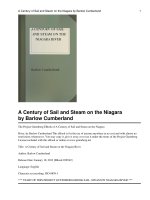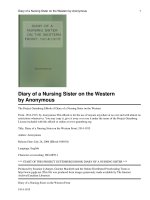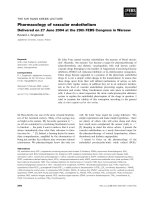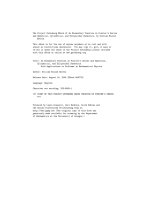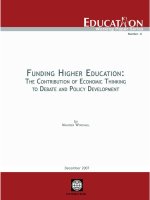The contribution of the scalar unparticle on the W production at e+ e- collider in randall sundrum model
Bạn đang xem bản rút gọn của tài liệu. Xem và tải ngay bản đầy đủ của tài liệu tại đây (1.08 MB, 8 trang )
Ha Noi Metroplolitan University
118
THE CONTRIBUTION OF THE SCALAR UNPARTICLE
ON THE W PRODUCTION AT e+e- COLLIDER IN RANDALL –
SUNDRUM MODEL
Dang Van Soa1, Bui Thi Ha Giang2
1
Hanoi Metropolitian University,
2
Hanoi National University of Education
Abstract: We evaluate the contribution of the scalar unparticle on the W-production at
the e + e − collision in the Randall-Sundrum model, which depend strongly on the collision
energy
s , the scaling dimension dU of the unparticle operator OU and the energy
scale ΛU . In case of left polarized e − beam, right polarized e + beam and vice versa, the
total cross-section reachs the maximum value.
Keywords: scalar unparticle, Randall-Sundrum model, ILC.
Email:
Received 12 November 2018
Accepted for publication 15 December 2018
1. INTRODUCTION
The Standard model has been a successful model in describing the particle physics. In
the Lagrangian of the Standard model, the scale invariance is broken at or above the
electroweak scale [1, 2]. The scale invariant sector has been considered as an effective
theory at TeV scale and that if it exists, it is made of unparticle suggested by Geogri [3, 4].
Based on the Banks-Zaks theory [5], unparticle stuff with nontrivial scaling dimension is
considered to exist in our world. The invariant Banks-Zaks field can be connected to the
SM particles [6]. Recently, the possibility of the unparticle has been studied with CMS
detector at the LHC [7, 8].
The effects of unparticle on properties of high energy colliders have been intensively
studied in Refs. [9-18]. In ref. [19], we evaluated the contribution of scalar unparticle on
the production of Higgs-radion in RS model. In this work, the contribution of the scalar
unparticle on the W-production at the e+e- collider in the Randall-Sundrum (RS) model.
The RS model is based on the non-factorizable geometry in the five space-time dimensions
and the extra dimension is compactified [20]. The RS model setup involves two three-
Scientific Journal − No27/2018
119
branes: UV brane, which gravity is localized at, and IR brane, which the SM fields are
localized at. The separation between the two 3-branes leads directly to the existence of an
additional scalar called the radion ( φ ), corresponding to the quantum fluctuations of the
distance between the two 3-branes [21-23].
The layout of this paper is as follows. In Section II, we give Feymans rules in the
Randall-Sudrum model. The contribution of the scalar unparticle on the W-production at
the e+e- collision is calculated in Section III. Finally, we summarize our results and make
conclusions in Section IV.
2. FEYMANS RULES IN THE RANDALL-SUNDRUM MODEL
In the RS model, radion and Higgs boson have the same quantum numbers. General
covariance allows a possibility of mixing between the radion and the Higgs boson.
Feynman rules for the couplings of Higgs and radion are showed as follows
where
g hW =
γb
d + γ b − κW γ bmW2
1
α b2
+
2
2kb0 8π sin θW
gφW =
γa
c + γ a − κW γ bmW2
1
α b2
+
2
2kb0 8π sin θW
κW =
3mW2 kb0
2Λφ2 ( k / M Pl ) 2
1
kb0 ~ 35
2
Ha Noi Metroplolitan University
120
b2 = 19 / 6 , a = −
d = cosθ −
cosθ
sinθ
6ξγ
,b =
, c = sinθ +
cosθ ,
Z
Z
Z
6ξγ
sinθ
Z
θW is the Weinberg angle, Z 2 = 1 + 6γ 2ξ (1 − 6ξ ) = β − 36ξ 2γ 2 is the coefficient of the
radion kinetic term after undoing the kinetic mixing, γ = υ / Λ φ ,υ = 246 GeV. The
mixing angle θ is
(5)
where mh0 and mφ0 are the Higgs and radion masses before mixing [21].
In RS model, there are four independent parameters Λ φ , mh , mφ , ξ that must be
specified to fix the state mixing parameters. We consider the case of Λ φ = 5 TeV and
k
= 0.1 , which makes the radion stabilization model most natural [22, 23].
M Pl
Feynman rules for the couplings of the scalar unparticle in the RS model are showed
as follows [19]
(6)
(7)
3. THE CONTRIBUTION OF THE SCALAR UNPARTICLE ON THE WPRODUCTION AT E+E- COLLIDERS
In this work, we restrict ourselves by considering only scalar unparticle. The scalar
unparticle propagator is given by [2, 4]
(8)
Scientific Journal − No27/2018
121
(9)
(10)
Using the above formulas, we will study the contribution of the scalar unparticle on
the collision process in which the initial state contains electron and positron, the final state
contains W + and W -.
(11)
The transition amplitude is given by
(12)
Here, q = p1 + p2 = k1 + k2 , s = ( p1 + p2 ) 2 is the square of the collision energy. The
model parameters are chosen as: λ ff = λWW = λ0 = 1 , mh = 125 GeV, mφ = 10 GeV [25,
26]. The cross section is flat when dU > 1.6 , so the dU is chosen as 1 < dU < 1.5 . We give
estimates for the cross-sections as follows
i) In Fig.1, the total cross-section is plotted as the function of Pe− , Pe+ , which are the
polarization coefficients of e− , e+ beams, respectively. The parameters are chosen as
s = 500 GeV, dU = 1.1 , ΛU = 1000 GeV. The figure indicates that the total cross-section
achieves the minimum value when Pe− = Pe+ = ±1 and the maximum value when
Pe− = 1, Pe+ = −1 or Pe− = −1, Pe+ = 1 .
ii) In Fig.2, the total cross-section is plotted as the function of dU in case of
Pe− = 1, Pe+ = −1 .
Ha Noi Metroplolitan University
122
The parameters are chosen as
s = 500 GeV, ΛU = 1000 GeV. From the figure we
can see that the cross section decreases rapidly as dU increases.
iii) In Fig.3, we evaluate the dependence of the total cross-section on the collision
energy
s in case of Pe− = 1, Pe+ = −1 . The collision energy is chosen in the range of 500
GeV ≤ s ≤ 1000 GeV (ILC). The parameters are chosen as dU = 1.1 , ΛU = 1000 GeV.
The figure shows that the total cross-section increases rapidly when the collision energy
s increases.
iv) In Fig.4, we evaluate the dependence of the total cross-section on the ΛU at the
fixed collision energy
s = 500 GeV. The polarization coefficients are chosen as
Pe− = 1, Pe+ = −1 . In case of the additional scalar unparticle propagator, the cross-section
decreases rapidly in the region of 1 TeV ≤ ΛU ≤ 3 TeV.
Table 1: Some typical values for the cross-section with the contribution of the scalar unparticle in
the e+e- →W-W+ collisions at the ILC in case of Pe- =1, Pe+ =1. The parameters are chosen as
dU = 1.1 and the masses mh =125 GeV, mΦ = 10 GeV.
Figure 1. The cross-section as a function of the Pe− , Pe+ polarization coefficients of the e− , e+
beams at ILC. The parameters are taken to be
s = 500 GeV, dU = 1.1, ΛU = 1000 GeV.
Scientific Journal − No27/2018
123
Figure 2. The cross-section as a function of the dU in e + e − → W −W + collision in case of
Pe − = 1, Pe+ = −1 . The parameters are chosen as
s = 500 GeV, ΛU = 1000 GeV.
Figure 3. The cross-section as a function of the collision energy s in e + e − → W −W + collision
in case of Pe − = 1, Pe+ = −1 . The parameters are chosen as dU = 1.1, ΛU = 1000 GeV.
Figure 4. The total cross-section as a function of the energy scale ΛU in e + e − → W −W + collision
in case of Pe − = 1, Pe+ = −1 . The parameters are taken to be
s = 500 GeV, dU = 1.1.
Ha Noi Metroplolitan University
124
4. CONCLUSION
In this paper, we have evaluated the contribution of the scalar unparticle on the W
production cross-sections in the Randall - Sundrum model at the e + e − collider, which
depend strongly on the collision energy
s , the scaling dimension dU of the unparticle
operator OU and the energy scale ΛU . In the e + e − → W −W + collision, with the
contribution of the scalar unparticle propagator, the cross-section is about 1010 times larger
than that of the W-production under the same conditions without the scalar unparticle
propagator. The readers can see detaily in Table 1.
Acknowledgements: The work is supported in part by the National Foundation for
Science and Technology Development (NAFOSTED) of Vietnam under Grant No. 103.012016.44.
REFERENCES
1.
H. Zhang, C. S. Li and Z. Li, Phys. Rev. D76 (2007) 116003.
2.
K. Cheung, W. Y. Keung and T. C. Yuan, Phys. Rev. Lett. 99 (2007) 051803.
3.
H. Georgi, Phys. Rev. Lett. 98 (2007) 221601.
4.
H. Georgi, Phys. Lett. B650 (2007) 275.
5.
T. Banks and A. Zaks, Nucl. Phys. B196 (1982) 189.
6.
S-L. Chen, X-G. He, Phys. Rev. D76 (2007) 091702.
7.
CMS Collaboration, Eur. Phys. J. C75 (2015) 235.
8.
CMS Collaboration, Phys. Rev. D93 (2016) 052011.
9.
P. Mathews and V. Ravindran, Phys. Lett. B657 (2007) 198.
10. A.T. Alan and N.K. Pak, EPL Vol.84, No.1 (2008) 11001.
11. S. Majhi, Phys. Lett. B665 (2008)44.
12. M.C. Kumar, P. Mathews, V.Ravindran and A.Tripathi, Phys. Rev. D77 (2008)
055013.
13. Sahin and B. Sahin, Eur. Phys. J. C55 (2008) 325.
14. T.Kikuchi and N.Okada, Phys. Rev. D77 (2008) 094012.
15. Friedland, M. Giannotti, M. Graesser, Phys. Lett. B678 (2009) 149.
16. H. Chen, G. Cvetic, C. S. Kim, Phys. Lett. B694 (2011)393.
17. S. Khatibi, M. M. Najafabadi, Phys. Rev. D87 (2013) No.3, 037701.
Scientific Journal − No27/2018
125
18. T.M. Aliev, S. Bilmis, M. Solmaz and I. Turan, Phys. Rev. D95 (2017) No.9, 095005.
19. D. V. Soa and B. T. H. Giang, Nucl. Phys. B 936 (2018) 1.
20. L. Randall and R. Sundrum, Phys. Rev. Lett. 83 (1999) 3370.
21. D. Dominici, B. Grzadkowski, J. F. Gunion and M. Toharia, Nucl.Phys. B671 (2003)
243.
22. C. Csaki, M. L. Graesser and G. D. Kribs, Phys. Rev. D63 (2001) 065002.
23. W. D. Goldberger and M. B. Wise, Phys. Rev. Lett. 83 (1999) 4922.
24. Ahmed, B. M. Dillon, B. Grzadkowski, J. F. Gunion and Y. Jiang, Phys. Rev. D95
(2017) 095019.
25. P. V. Dong, H. N. Long, D. V. Soa and N. H. Thao, JHEP 1110 (2011), 018.
26. D. V. Soa et al., Mod. Phys. Lett. A27 (2012)1250126.
ĐÓNG GÓP CỦA U - HẠT VÔ HƯỚNG VÀO SỰ TẠO W-BOSONS
TẠO VA CHẠM e+e- TRONG MẪU RANDALL-SUNDRUM
Tóm tắt: Chúng tôi tính toán đóng góp của U - hạt vô hướng vào tiết diện tạo hạt W tại
va chạm e+e- trong mẫu Randall - Sundrum, mà nó phụ thuộc năng lượng va chạm, thứ
nguyên tỉ lệ và thang năng lượng. Trong trường hợp chuẩn phân cực trái, phải ngược
nhau thì tiết diện đạt cực đại
Từ khóa: U - hạt vô hướng, mẫu Randall - Sundrum, ILC.

